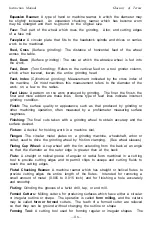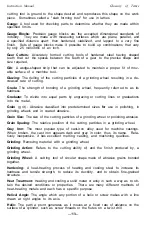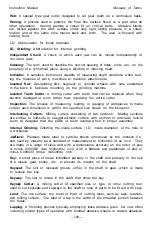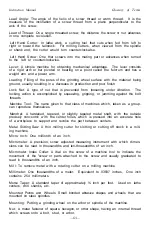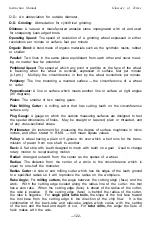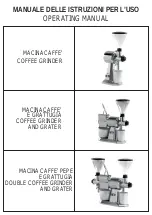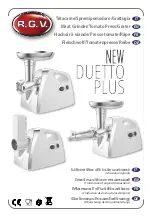
Instruction Manual Glossary of Terms
Saw Cummer:
A grinding wheel used for gumming or sharpening saws.
Scleroscope:
An instrument for determining the relative hardness of materials by
a drop and rebound method.
Scratches:
Marks left on a ground surface caused by a dirty coolant or a grinding
wheel unsuited for the operation.
Set Screw:
Usually a hardened steel screw having either no head or a square head
and with various designs of points or ends to lock or tighten adjustable machine
parts in position on a shaft.
Set-up:
The term used to describe the positioning of the workpiece, attachments
and cutting tools on a machine tool.
S.F.P.M.: Surface feet per minute. See "Peripheral Speed" Multiply the circum
ference in feet by the wheel revolutions per minute.
Shank:
The noncutting end of a tool which fits into the holding device for driving,
as the taper shank on a drill.
Shellac Bond:
A bonding material, the principal constituent of which is shellac.
Shell Reamer:
A reamer which as a slightly tapered hole to fit
on
the end of an
arbor or shank for holding and driving in a machine. One arbor can be used for
several reamer sizes. Should the reamer become damaged, only the reamer end
need be replaced.
Side-Clearance Angle:
An obsolete term which refers to the amount of angle ground
on the sides of a single-point cutting tool. It is replaced by the new term
side-
relief angle.
Side-Milling Cutters:
Cutters which have cutting teeth on one or both sides as
well as on the circumference.
Side-Relief Angle:
On a single-point cutting tool, the angle between the portion of
the flank immediately below the cutting edge and a line drawn through this cutting
edge perpendicular to the base. Also, the angle of relief on the sides of milling
cutters.
Silicone Carbide:
An abrasive made from coke and silica sand (SiC).
Sine of an Angle:
In a right triangle, the ratio of the side opposite to the side
adjacent.
Sine Bar:
A flat piece of metal accurately ground parallel and square to which is
attached two hardened and ground steel plugs having the same diameter and usually
spaced either 5 or 10 inches apart. The sine bar is used to measure angles accurately.
Also, the sine bar represents the hypotenuse of a right triangle
Single-Point Tools:
Cutting tools for use in a lathe, planer, or shaper. Single-point
tools have one face and one continuous cutting edge which produce the machined
surface.
Slabbing Cutter:
A wide plain milling cutter designed for heavy roughing cuts.
Sleeve:
A round piece of metal having a straight or tapered hole which fits over or
into another piece to adapt parts to fit, as a taper sleeve for a lathe center.
Slitting Saw:
A thin milling cutter of the plain type used for slotting or cutting off
material in the milling machine.
—124—









